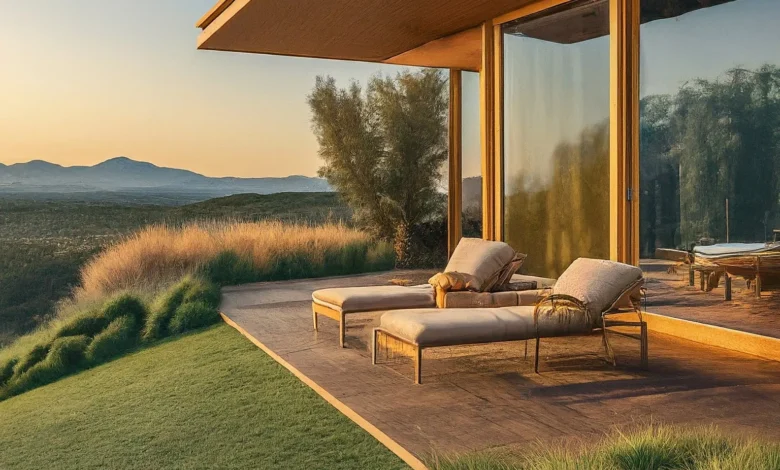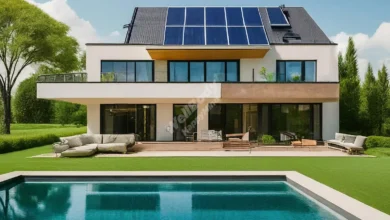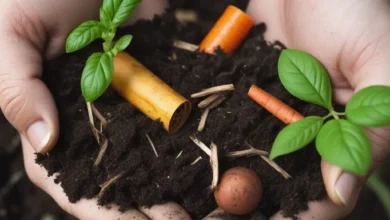Eco-Retreat: Design a Home That Heals You and the Earth

Introduction
Imagine a home that nurtures your well-being while also caring for our planet. This is the essence of an eco-retreat – a living space that combines sustainable design with wellness-focused features. In today’s world, where environmental concerns and personal health are top priorities, creating an eco-retreat offers a powerful solution to both.
Did you know that we spend about 90% of our time indoors? This statistic highlights the crucial impact our living spaces have on our health and happiness. By designing an eco-friendly home, we can create an environment that not only reduces our carbon footprint but also actively promotes our physical and mental wellness.
In this article, we’ll explore the concept of an eco-retreat and discover how you can transform your living space into a sanctuary for both you and the environment.
Understanding the Eco-Retreat Concept
What is an Eco-Retreat?
An eco-retreat is a home designed with both environmental sustainability and personal wellness in mind. It goes beyond traditional eco-friendly houses by actively incorporating elements that promote physical and mental health.
Key principles of an eco-retreat include:
- Using sustainable materials
- Maximizing energy efficiency
- Conserving water
- Improving indoor air quality
- Incorporating natural elements
Unlike conventional homes, eco-retreats prioritize the well-being of both inhabitants and the planet. They create a harmonious living environment that reduces environmental impact while fostering a sense of peace and connection with nature.
The Intersection of Sustainability and Wellness
Eco-retreats bridge the gap between green living and personal health. By focusing on sustainable practices, these homes naturally create conditions that support human wellness. For example:
- Energy-efficient design often leads to better temperature regulation, improving comfort.
- Non-toxic materials reduce exposure to harmful chemicals, benefiting overall health.
- Natural lighting and ventilation boost mood and air quality.
This synergy between sustainability and wellness is at the heart of the eco-retreat concept, offering a holistic approach to better living.
The Healing Power of Eco-Friendly Design
Creating an eco-retreat isn’t just about being kind to the planet – it’s about nurturing your health and well-being too. Let’s explore how eco-friendly design can have a positive impact on both your physical and mental health.
Physical Health Benefits
Improved Air Quality
One of the most significant benefits of an eco-retreat is the enhanced air quality it provides. Key features that contribute to cleaner air include:
- Natural ventilation systems
- Use of low-VOC materials
- Indoor plants for natural air purification
- HEPA air filters
These elements work together to reduce indoor air pollution, which can be up to five times worse than outdoor air pollution in conventional homes.
Reduced Exposure to Toxins
Eco-retreats prioritize the use of non-toxic materials, significantly reducing your exposure to harmful substances. Common household toxins to avoid include:
- Formaldehyde (found in some furniture and building materials)
- Phthalates (often present in vinyl flooring and synthetic fragrances)
- Lead (can be in old paint or contaminated water)
- Pesticides (used in conventional gardening)
- Flame retardants (found in some upholstery and electronics)
By eliminating these toxins, eco-retreats create a safer living environment that supports your long-term health.
Mental Health Benefits
Connection with Nature
Eco-retreats often incorporate biophilic design – an approach that brings natural elements into the living space. This connection with nature has been shown to:
- Reduce stress and anxiety
- Improve mood and cognitive function
- Enhance creativity and productivity
Simple ways to incorporate biophilic design include adding indoor plants, using natural materials like wood and stone, and maximizing natural light.
Stress Reduction through Biophilic Design
Biophilic design goes beyond just adding a few plants to your home. It’s about creating an environment that mimics the calming effects of nature. Examples include:
- Water features that provide soothing sounds
- Nature-inspired patterns and textures in decor
- Views of green spaces or landscapes
- Use of earthy, natural colors
These elements can help lower cortisol levels (the stress hormone) and promote a sense of peace and tranquility in your living space.
By incorporating these physical and mental health benefits, eco-retreats offer a holistic approach to wellness that goes hand-in-hand with environmental sustainability. In the next section, we’ll explore the key elements that make up an eco-retreat home.
Key Elements of an Eco-Retreat Home
Creating an eco-retreat involves thoughtful design and sustainable choices in various aspects of your home. Let’s explore the essential elements that make up an eco-friendly, wellness-promoting living space.
Sustainable Materials
The foundation of any eco-retreat starts with the materials used in its construction and furnishing. Here’s a list of eco-friendly building materials:
- Bamboo
- Reclaimed wood
- Recycled steel
- Hempcrete
- Cork
- Recycled glass
- Natural linoleum
These materials offer several benefits:
- Reduced environmental impact: They often require less energy to produce and can be recycled.
- Improved indoor air quality: Many are naturally low in VOCs (volatile organic compounds).
- Durability: Sustainable materials are often long-lasting, reducing the need for replacements.
Energy Efficiency
A key aspect of eco-retreat design is maximizing energy efficiency. This not only reduces your carbon footprint but can also lead to significant cost savings.
Passive Solar Design
Passive solar design uses the sun’s energy for heating and cooling. Here’s a brief explanation:
- Orientation: The house is positioned to maximize sunlight exposure.
- Windows: Large, south-facing windows capture sunlight in winter.
- Thermal mass: Materials like concrete floors absorb heat during the day and release it at night.
- Shading: Overhangs or deciduous trees provide shade in summer.
Renewable Energy Sources
Consider these options for powering your eco-retreat:
| Energy Source | Pros | Cons |
|---|---|---|
| Solar panels | Clean, abundant energy | Initial cost, weather-dependent |
| Wind turbines | Effective in windy areas | Noise, visual impact |
| Geothermal | Consistent, low maintenance | High installation cost |
| Biomass | Uses organic waste | Requires fuel source |
Water Conservation
Efficient water use is crucial in an eco-retreat. Two key strategies are:
Rainwater Harvesting Systems
These systems collect and store rainwater for later use. Benefits include:
- Reduced reliance on municipal water supply
- Lower water bills
- Ideal for irrigation and non-potable uses
Greywater Recycling
Greywater systems reuse water from sinks, showers, and washing machines. This:
- Reduces overall water consumption
- Lessens the load on septic or sewer systems
- Can be used for irrigation or toilet flushing
Indoor Air Quality
Maintaining clean air inside your eco-retreat is vital for health and comfort.
Natural Ventilation Strategies
- Cross-ventilation: Placing windows on opposite walls
- Stack effect: Using vertical spaces to create air movement
- Atrium or courtyard designs: Promoting air circulation
- Operable skylights: Allowing hot air to escape
Low-VOC Materials and Finishes
VOCs (Volatile Organic Compounds) can off-gas and cause health issues. Choose low-VOC options for:
- Paints and stains
- Flooring (e.g., natural linoleum, cork)
- Furniture and cabinetry
- Cleaning products
By incorporating these key elements, you lay the groundwork for a home that’s not only environmentally friendly but also promotes your overall well-being. In the next section, we’ll delve into designing specific healing spaces within your eco-retreat.
Designing Healing Spaces Within Your Eco-Retreat
Creating dedicated areas for relaxation and rejuvenation is essential in an eco-retreat. Let’s explore how to design spaces that promote wellness and peace.
Meditation and Yoga Areas
A calm space for mindfulness practices can significantly enhance your mental well-being. Key features for a calming atmosphere include:
- Soft, natural lighting
- Neutral, soothing colors
- Minimal clutter
- Comfortable, eco-friendly flooring (like cork or bamboo)
- Sound-absorbing materials for quietude
- Views of nature, if possible
Biophilic Elements
Incorporating nature into your living spaces is a cornerstone of eco-retreat design. Here are some ideas:
- Install a living wall or vertical garden
- Use natural materials like stone or reclaimed wood
- Create indoor water features
- Choose nature-inspired patterns for textiles
- Place potted plants throughout your home
Using Natural Light Effectively
Maximize natural light with these tips:
- Install large windows or skylights
- Use light-colored, reflective surfaces
- Place mirrors strategically to bounce light
- Choose sheer, eco-friendly window treatments
- Consider light tubes for dark areas
Non-toxic Bedrooms for Restorative Sleep
Your bedroom should be a sanctuary for sleep. Here’s a brief guide for choosing organic bedding and mattresses:
- Look for GOTS-certified organic cotton sheets and pillowcases
- Choose mattresses made from natural latex, organic cotton, or wool
- Avoid synthetic materials and flame retardants
- Opt for hypoallergenic pillows filled with organic materials
Checklist for a sleep-friendly environment:
□ Use blackout curtains or shades
□ Keep electronics out of the bedroom
□ Maintain a cool temperature (60-67°F / 15-19°C)
□ Use calming, nature-inspired colors
□ Ensure proper ventilation
□ Incorporate air-purifying plants like snake plants or peace lilies
Outdoor Spaces: Extending Your Eco-Retreat
The healing power of your eco-retreat doesn’t stop at your doorstep. Outdoor spaces play a crucial role in promoting wellness and sustainability.
Creating a Healing Garden
A thoughtfully designed garden can be a powerful tool for stress relief and healing. Here’s a list of therapeutic plants and their benefits:
| Plant | Benefit |
|---|---|
| Lavender | Reduces anxiety and promotes sleep |
| Chamomile | Calms nerves and aids digestion |
| Aloe Vera | Soothes skin and purifies air |
| Jasmine | Improves mood and sleep quality |
| Rosemary | Enhances memory and concentration |
| Echinacea | Boosts immune system |
Sustainable Landscaping Practices
Extend your eco-friendly approach to your outdoor spaces with these techniques:
Water-wise Gardening
- Use drought-resistant plants native to your area
- Install a drip irrigation system for efficient watering
- Mulch garden beds to retain moisture
- Collect rainwater for garden use
Supporting Local Ecosystems
- Plant a variety of native species
- Create habitats for local wildlife
- Avoid chemical pesticides and fertilizers
- Compost kitchen and garden waste
- Install bird feeders and baths
- Consider creating a small pond or water feature
By thoughtfully designing both indoor and outdoor spaces, you can create an eco-retreat that nurtures your well-being while supporting the environment. In the next section, we’ll discuss practical steps to bring your eco-retreat vision to life.
Practical Steps to Create Your Eco-Retreat
Transforming your home into an eco-retreat may seem daunting, but with a systematic approach, it’s achievable. Let’s break it down into manageable steps.
Assessment of Your Current Home
Start by evaluating your existing space. Use this checklist to identify areas for improvement:
□ Energy efficiency (insulation, windows, appliances)
□ Water usage (fixtures, outdoor irrigation)
□ Indoor air quality (ventilation, VOC sources)
□ Natural light availability
□ Use of sustainable materials
□ Presence of toxic substances (lead paint, asbestos)
□ Outdoor space utilization
Prioritizing Changes
Not all eco-friendly upgrades can be done at once. Here’s a table to help you prioritize:
| Short-term Upgrades | Long-term Upgrades |
|---|---|
| Switch to LED lighting | Install solar panels |
| Use low-VOC paints | Upgrade to energy-efficient windows |
| Install a smart thermostat | Implement a greywater system |
| Add indoor plants | Create a green roof |
| Use natural cleaning products | Replace old HVAC systems |
Working with Professionals
For major renovations, working with eco-conscious professionals is crucial. Tips for finding the right experts:
- Look for certifications like LEED or Passive House
- Ask for portfolios of sustainable projects
- Check references and read reviews
- Ensure they understand your vision for an eco-retreat
Overcoming Challenges in Eco-Retreat Design
Creating an eco-retreat can come with its own set of challenges. Let’s address some common misconceptions and concerns.
Addressing Common Misconceptions
Here are some myths about eco-friendly homes and their rebuttals:
- Myth: Eco-friendly homes are always expensive.
Reality: While some upgrades have upfront costs, they often lead to long-term savings. - Myth: Sustainable materials are less durable.
Reality: Many eco-friendly materials are designed for longevity and performance. - Myth: Eco-retreats sacrifice comfort for sustainability.
Reality: Eco-retreats often enhance comfort through better air quality and temperature regulation.
Balancing Cost and Sustainability
Strategies for budget-friendly eco-design:
- Start small and upgrade incrementally
- Focus on energy efficiency for quick returns
- Explore tax incentives and rebates for eco-friendly upgrades
- Consider second-hand or reclaimed materials
- DIY where possible, but know when to call professionals
The Future of Eco-Retreats
As we look ahead, the concept of eco-retreats is likely to evolve with emerging technologies and growing awareness of wellness-focused architecture.
Emerging Technologies
- Smart home systems for optimized energy use
- Advanced air purification technologies
- Self-sustaining water and energy systems
- Biodynamic lighting that mimics natural light cycles
Growing Trend of Wellness-Focused Architecture
The future will likely see a greater integration of health-promoting features in sustainable design, such as:
- Spaces designed for mental health support
- Integration of home fitness and telehealth technologies
- Community-focused eco-developments
Conclusion
Creating an eco-retreat is more than just a home improvement project – it’s a commitment to your well-being and the planet’s health. By incorporating sustainable materials, energy-efficient designs, and wellness-focused spaces, you can transform your living environment into a sanctuary that nurtures both you and the Earth.
Remember, the journey to an eco-retreat doesn’t have to happen overnight. Start with small changes, and gradually work towards your ideal sustainable and healing home. Every step you take not only improves your immediate living space but contributes to a larger movement towards sustainable living.
We encourage you to take action today. Whether it’s adding a few plants to your space, switching to non-toxic cleaning products, or planning a major eco-friendly renovation, each choice moves you closer to creating your own eco-retreat.
By designing a home that heals you and the Earth, you’re not just improving your life – you’re contributing to a healthier, more sustainable future for all. So, why wait? Start your eco-retreat journey today and experience the transformative power of living in harmony with nature and your own well-being.



